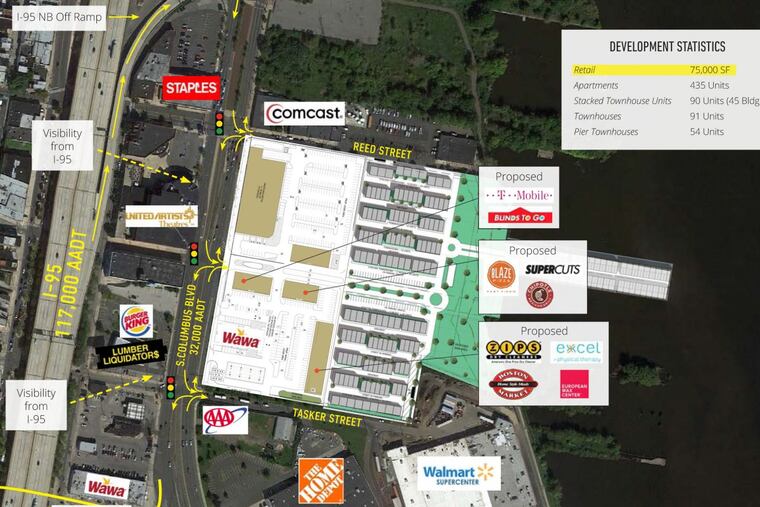Gas and water(front) don't mix; and they mess up plan for the Delaware | Opinion
We must not sacrifice long term community growth for short-term private gain, and we must guard against projects that threaten to irreparably harm the future of a walkable and pedestrian-scaled waterfront.

In this year of Philadelphia's overcoming naysayers after years of disappointment, those of us working along the Delaware River are reminded that we must never lose faith in our vision for reclaiming one of our city's greatest underutilized assets: our waterfront.
Anyone who's visited recently knows that the Delaware River waterfront has made great strides in the last decade with the addition of parks, trails, and attractions like Race Street Pier, Spruce Street Harbor Park, and Washington Avenue Pier, and is now on the cusp of achieving a long-planned centerpiece park at Penn's Landing. Unfortunately, that progress is facing a new challenge by a development that is inconsistent and incompatible with the success we've had in reconnecting our waterfront with our neighborhoods.
The current momentum on the waterfront is no accident: In 2012, the Delaware River Waterfront Corp. (DRWC) created a master plan for the central Delaware with input from thousands of residents and civic leaders. The city formally adopted the plan in 2013, making it the official road map for development on the waterfront.
The theory behind the master plan is simple: Strategic investment in parks, trails, and connector streets will create access to the river for all, and in turn leverage high-quality private development that will capture and extend the sense of community and street life found in the neighborhoods west of I-95 to the waterfront. This formula is beginning to pay dividends with infill development and a steady drumbeat of mid-rise projects in waterfront neighborhoods from Fishtown to Pennsport.
In an area as large and storied as Philadelphia's post-industrial waterfront, we know it requires time and patience to make strategic investments to convert blighted vacancy to the green, accessible, and vibrant waterfront neighborhoods we envisioned in the master plan. We also know that to reach that vision, we must not sacrifice long-term community growth for short-term private gain, and we must guard against projects that threaten to irreparably harm the future of a walkable and pedestrian-scaled waterfront.
This vision faces a major test at 2 p.m. Wednesday at the Zoning Board of Adjustment (ZBA). Tower Investments is proposing to locate a Super Wawa gas station in Pennsport at Tasker Street and Columbus Boulevard. This proposal shows flagrant disregard for the years of community-driven planning DRWC has led, and is vehemently opposed by the community. While the master plan calls for a mix of uses (residential, commercial, retail, and recreational), auto-dominated uses like gas stations are prohibited on the blocks adjacent to the river's edge to encourage higher quality development. This isn't a burdensome regulation. There are many better uses of waterfront land than a gas station. Lamentably, over DRWC's and Pennsport's vociferous objections, the proposal is advancing to the Zoning Board of Adjustment for a variance.
DRWC, the city, and many other funding partners have made major investments in a trail and park system along the waterfront, especially in Pennsport, from Washington Avenue to Pier 70 Boulevard. Due to this investment, there are now new mixed-use residential developments proposed for the vacant land around the proposed gas station that will suffer if gas pumps are approved. Let's not halt the waterfront's progress by allowing a proposal that undermines the ongoing investment in the area and violates the zoning established through years of consensus-building with community leaders and developers.
DRWC has a strong commitment to working with developers along the waterfront to demonstrate the value of the master plan and to help identify appropriate uses that balance the community's goals with the developers' objectives, with a track record to match. Indeed, our opposition to gas pumps isn't anti-development; the master plan doesn't work without high-quality development that fits a prime waterfront location. The master plan only requires that buildings be constructed with features that meet the high level of connectivity and access we're seeking as a city. Uses like the urban-format Wawas seen in Center City are perfectly suited for a mixed-use community along the Delaware.
If we are to succeed in our mission of transitioning the waterfront from a post-industrial to a green and accessible neighborhood, and in converting Delaware Avenue from engine of industry to urban boulevard, we must work together with like-minded developers to fulfill that mission. But we must never settle for development that violates our standards.
As Philadelphia sees historic growth, attention, and victories, it's time to stand up for our waterfront, for the years of planning that has engaged thousands of residents, and for the substantial investments we've made to create public access, parks, and trails. We must signal that we expect better, because we as Philadelphians deserve better.
If we get this right, we can have a properly connected, world-class waterfront for all to enjoy.
Let's keep a high bar along the waterfront and be glad 10 years from now that we did.
Joseph Forkin is president of the Delaware River Waterfront Corp.